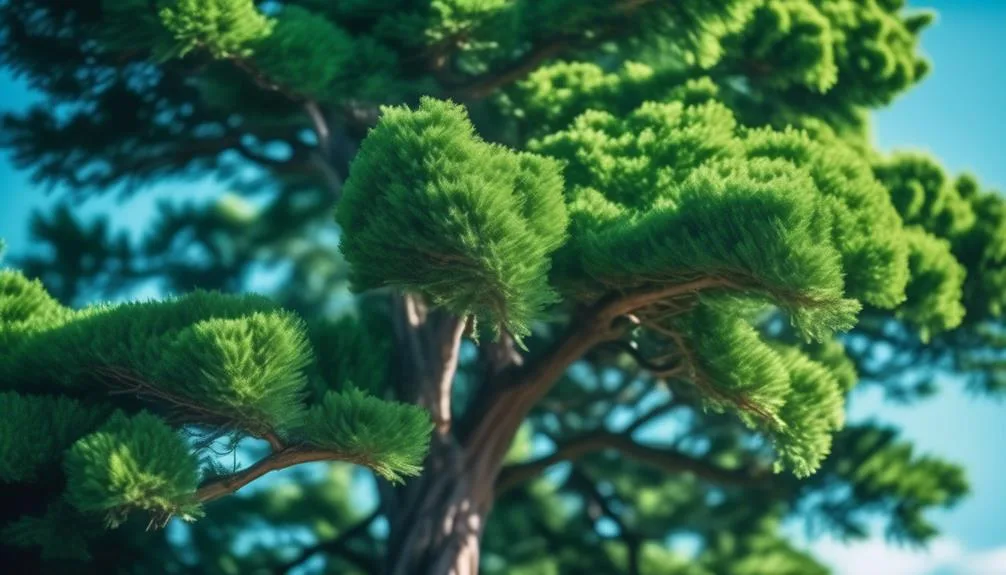Caring for cedar trees throughout the year is essential for their health and vitality. Each season brings unique needs, from gentle spring care to winter protection.
To ensure the longevity of these majestic trees, it's crucial to understand the specific care they require. From preparing for summer heat to fortifying against autumn winds, each season presents its own challenges and opportunities for nurturing cedar trees. Understanding these seasonal care tips is key to maintaining their resilience.
Spring Care Tips
As spring approaches, prioritize nourishing and rejuvenating your cedar trees to ensure their healthy growth and vitality throughout the season. Start by conducting a soil test to understand the pH levels and nutrient composition, allowing you to make informed decisions about fertilization. Cedar trees thrive in slightly acidic soil, so amending the soil accordingly can significantly benefit their health.
Additionally, establish a proper watering schedule to support their growth. While cedar trees are drought-tolerant once established, consistent watering during the spring is crucial, especially in the absence of regular rainfall. Adequate moisture will prevent stress and promote robust foliage.
Summer Maintenance
To maintain the health and vibrancy of your cedar trees during the summer months, focus on consistent watering and monitoring for common pests and diseases.
It's crucial to pay attention to the following summer maintenance tips:
- Watering Schedule: During hot summer months, it's important to ensure that your cedar trees receive an adequate amount of water. Be mindful of dry spells and adjust your watering schedule accordingly to keep the soil consistently moist but not waterlogged.
- Monitoring for Pests and Diseases: Regularly inspect your cedar trees for signs of common pests such as spider mites or diseases like cedar rust. Early detection can help prevent widespread infestations or infections.
- Pruning Techniques: Consider light pruning to remove any dead or diseased branches, allowing better air circulation and promoting healthy growth during the summer.
Fall Preparation
Prepare your cedar trees for the upcoming fall season by implementing key maintenance practices to ensure their health and resilience. As the weather cools down, it's important to focus on leaf mulching and soil aeration to support the trees through the changing season. Leaf mulching involves spreading a layer of shredded leaves around the base of the cedar trees, which helps to regulate soil temperature and moisture, and provides essential nutrients as the leaves decompose. Additionally, soil aeration can be achieved by using a garden fork to gently loosen the soil around the tree, improving air circulation, and allowing water and nutrients to reach the roots more effectively. Consider incorporating these practices into your fall maintenance routine to ensure your cedar trees remain strong and vibrant throughout the season.
| Fall Preparation Tips for Cedar Trees | |
|---|---|
| Leaf Mulching | Spread a layer of shredded leaves around the base of the trees to regulate soil temperature and moisture, and provide essential nutrients. |
| Soil Aeration | Use a garden fork to gently loosen the soil around the tree, improving air circulation, and allowing water and nutrients to reach the roots more effectively. |
Winter Protection
Protect your cedar trees during the winter months by implementing key strategies to safeguard their health and resilience. Winter can be harsh, but with the right care, your cedar trees can thrive.
Here are some essential tips to protect your cedar trees during the winter:
- Snow cover: Gently brush off heavy snow from the branches to prevent breakage and damage to the tree.
- Mulch insulation: Apply a thick layer of mulch around the base of the tree to provide insulation and protect the roots from freezing temperatures.
- Hydration: Water your cedar trees periodically during the winter months, especially if there's a lack of snow cover, to prevent dehydration and maintain their health.
Year-Round Maintenance
Regularly inspecting your cedar trees for signs of disease or infestation is essential for year-round maintenance and ensuring their continued health and vitality.
Pruning techniques play a crucial role in maintaining the shape and health of cedar trees. Regularly trim away any dead or diseased branches to promote new growth and maintain an attractive appearance.
Additionally, proper soil nutrition is vital for the overall health of your cedar trees. Consider conducting soil tests to ensure the pH levels and nutrient content are suitable for cedar tree growth. Depending on the results, you may need to add fertilizer or other soil amendments to provide the necessary nutrients.
Conclusion
By implementing these simple care tips, your cedar trees can thrive in every season, staying healthy and resilient. With proper attention, you can foster growth, prevent diseases, and shield your trees from harsh weather.
As you tend to your cedar trees, envision the lasting impact they'll have on your landscape, bringing beauty and vitality for years to come.
Happy gardening!

My interest in trees started when I first saw the giant sequoias in Yosemite.
I was a teenager then, and I remember thinking, “I need to learn more about this.”
That moment stuck with me.
A few years later, I went on to study forestry at Michigan Tech.
Since graduating, I’ve worked in a mix of hands-on tree care and community education.
I’ve spent over ten years helping people understand how to plant, maintain, and protect the trees in their neighborhoods.
I don’t see trees as just part of the landscape.
They are living things that make a real difference in our daily lives.
